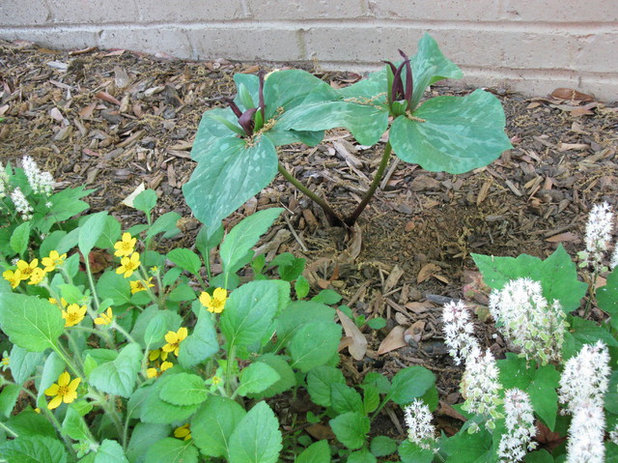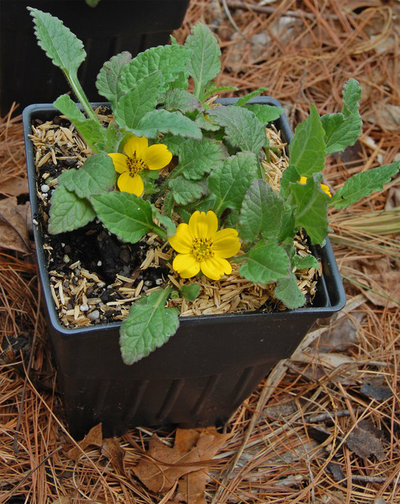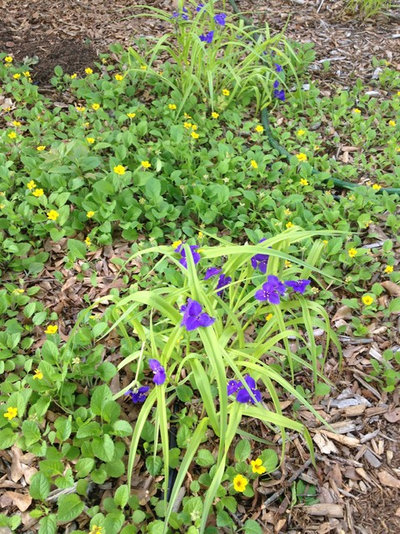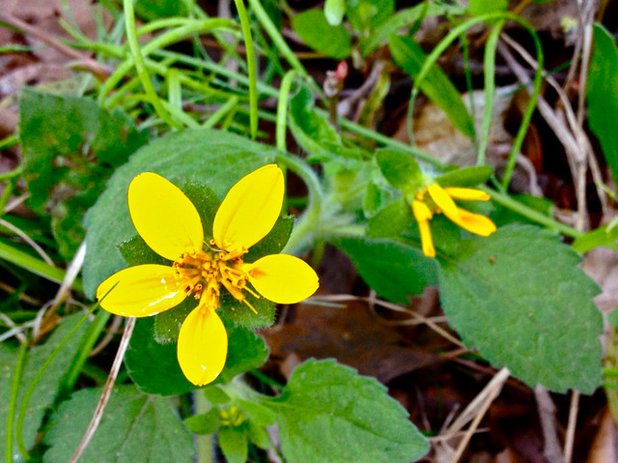Green and gold (
Chrysogonum virginianum) is a tough woodland native wildflower that can handle a wide range of conditions, from dry shade to full sun, in moist soil. It blooms in midspring, after the earliest wildflowers, and continues into early summer. In addition to the spring blooms, long-lasting foliage grows close to the ground so that it can fill in around other perennials and shrubs without creating conflict. This plant is even tough enough to handle light foot traffic; it can be planted very close to stepping stones or a pathway without the worry of damaging it when you stray off the path.
I have mine growing on the edge of a grove of pine trees, where they get only about two hours of sun a day. Over the course of two years, each plant has expanded tenfold — pretty good for less-than-ideal conditions. If these were to get too big, it would be easy to dig up the offsets for transplanting in the fall.

Earth Design, Inc.
Botanical name: Chrysogonum virginianumCommon names: Golden star, green and gold, golden knee
Origin: Green and gold’s native range is from southern New York state to northern Florida and west to Ohio in the North and eastern Louisiana in the South.
Where it will grow: Hardy to -20 degrees Fahrenheit (USDA zones 5 to 9; find your zone). There are three botanical varieties of this plant:
virginianum,
brevistolon, and
australe, originating from the northern, central and southern parts of the range, respectively. The variety
australe is not as cold hardy as
virginianum.
Shown: A nice combination of early- to mid-spring woodland natives: green and gold, toadshade (
Trillium sessile) and foamflower (
Tiarella cordifolia)
 Water requirement:
Water requirement: Tolerates a range of soil moistures, from dry to moist
Light requirement: Grows best in partial or dappled shade; tolerates full shade but will not be as vigorous; can handle full sun, but only if there is consistently moist soil
Mature size: The foliage typically grows as a leafy mat 3 to 4 inches tall, with the flowers growing one to several inches above the leaves. The plant’s spread varies; one variety (
virginianum) spreads slowly by rhizomes and will easily grow to 12 to 18 inches across; the variety
australe is a faster-spreading variety that uses aboveground runners that can extend several feet at a time.
Benefits and tolerances: A tough native ground cover for open shade and a range of soil moistures; deer tend not to bother this plant; tolerates alkaline soils, which is a benefit near lawns and foundations; durable enough to handle occasional foot traffic
Seasonal interest: Bright yellow, 1- to 1½-inch flowers cover the ground in May and June; blooming is sporadic later on through the summer. The foliage is long lasting, sometimes persisting through the winter.
When to plant: Container plants can be put out in spring and fall; transplanting is best done in the fall.
Shown: A 2-year-old patch in early spring. In mild winters the foliage is semi-evergreen, though it may look a little ratty by the beginning of spring. Golden Alexanders (
Zizia aurea) is the other plant in this photo.
 Distinguishing traits.
Distinguishing traits. The yellow composite flowers have five large ray flowers surrounding a central disk containing many more tiny disk flowers. The petals of the ray flowers have three teeth at the end of each. The leaves and stems are covered with fine hairs. After blooming, the plants send out rhizomes or runners (depending on the variety) that root and establish new offsets of the parent plant.
Shown: A recently purchased pot of the
australe variety. In addition to its having aboveground runners, the flowers of this variety tend to be on shorter stems.

Earth Design, Inc.
How to use it. This low-growing ground cover works really well along paths and at the front edge of a border. In a naturalistic setting with dappled shade, it can be used as an understory plants, like underneath birch trees. The fast-spreading
australe variety can be used to fill in between established plants. The more densely growing
virginianum variety
could also be used in a more formal garden, where it would likely stay in place. Since the plants form interconnected mats, they are good at stabilizing a slope to reduce erosion.
Green and gold is a good source of pollen and nectar for native bees and flies. Some other native plants that might bloom along with green and gold are wild geranium (
Geranium maculatum), woodland phlox (
Phlox divaricata) and crested iris (
Iris cristata).
Shown: The flowers of green and gold complementing the purple blooms of Ohio spiderwort (
Tradescantia ohiensis)
 Planting notes.
Planting notes. Divisions every three to five years will keep the plants vigorous. To get more plants, you can take new offsets from the parent plant in early summer after they begin to root. If you wait until fall, these offsets may be mature enough to transplant directly.
Both varieties are available from many native plant nurseries, as well as some larger retailers. Available cultivars include:
- ‘Eco Lacquered Spider’: An australe variety cultivar with shiny dark green foliage and very long runners
- ‘Allen Bush’ (shown) and ‘Pierre’: From the virginianum variety; they have longer blooming times than the native plant
- ‘Superstar’, also known as ‘Norman Singer’s Form’: Probably from the virginianum variety and does well in drier locations
Photo by Fritz Flohr Reynolds





